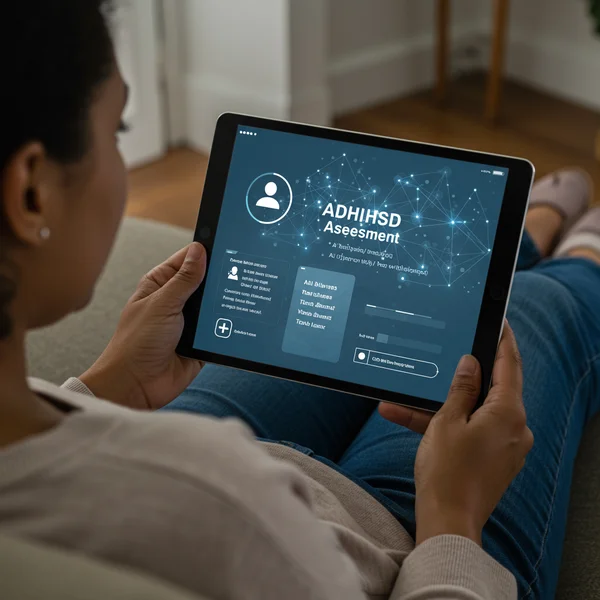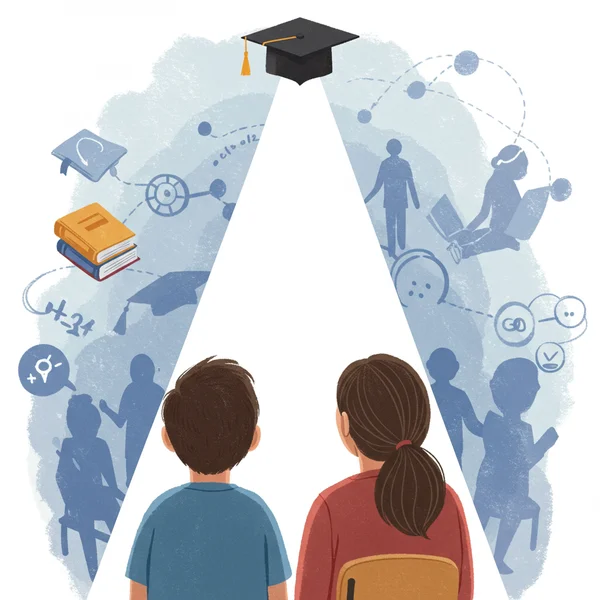ADHD Assessment for Kids & Teens: Online Screening Guide
As a parent, seeing your child struggle with focus, act on impulse, or fall behind in school can be a deeply concerning experience. If you find yourself asking whether these struggles point to ADHD, this guide is here to offer clarity and support. We'll walk through the common signs of ADHD in youth and explain how a reliable online screening can be a valuable first step toward understanding your child's needs and planning for a brighter future.
Recognizing ADHD Symptoms in Children & Teens
Attention-Deficit/Hyperactivity Disorder (ADHD) is a neurodevelopmental condition that affects how the brain manages attention, impulsivity, and activity levels. While many children can be energetic or have moments of inattention, for those with ADHD, these patterns are persistent and significantly impact their ability to function at school, at home, and with friends. The symptoms can present differently depending on a child's age and personality.
Common Signs in Younger Children (Ages 6-12)
In elementary and middle school-aged children, ADHD symptoms are often more noticeable and can be grouped into two primary categories: inattention and hyperactivity/impulsivity. It's important to remember that a child may show signs from one or both categories.
-
Inattentive Symptoms: A child might frequently lose things needed for tasks, seem not to listen when spoken to directly, be easily distracted by external stimuli, or struggle to follow through on instructions and finish homework or chores. This isn't a sign of defiance but a genuine difficulty with executive functions.
-
Hyperactive-Impulsive Symptoms: This can look like constant fidgeting or squirming in their seat, leaving their seat when remaining seated is expected, or running and climbing in inappropriate situations. Impulsivity may show up as blurting out answers before a question is completed or having trouble waiting their turn.

How ADHD Presents in Adolescents (Ages 13-17)
As children enter their teen years, the presentation of ADHD often shifts. The overt hyperactivity seen in younger children may lessen, becoming a more internal feeling of restlessness. Inattention and executive function challenges, however, can become more pronounced as academic and social demands increase.
An ADHD assessment for teens often uncovers challenges with organization, time management, and planning for long-term projects. A teen might consistently procrastinate on assignments, have a messy backpack and room, or feel overwhelmed by the steps needed to achieve a goal. Socially, they may interrupt conversations or have difficulty regulating their emotions, which can strain friendships.
Beyond the Classroom: Impact on Daily Life & Relationships
The impact of ADHD extends far beyond grades. These challenges can affect a child’s self-esteem, leading to feelings of being "lazy" or "not smart enough." Friendships can be difficult to maintain due to impulsive comments or missing social cues. At home, the daily struggle to complete homework or chores can cause significant family friction. Understanding that these behaviors stem from a neurological difference, not a character flaw, is the first step toward providing effective support. An online ADHD assessment can provide the initial clarity needed to start this journey.
Why Early ADHD Screening for Children Matters
Identifying potential ADHD early on is not about labeling a child; it's about unlocking the right support to help them thrive. Waiting can lead to years of unnecessary struggle and damage to a child's confidence. An early screening helps set the stage for positive change and empowers both you and your child with knowledge.
Benefits of Timely Intervention and Support
When a child's challenges are understood, you can begin to implement strategies that work with their brain, not against it. Timely intervention can lead to improved academic performance, stronger social skills, and a healthier parent-child relationship built on understanding rather than conflict. It helps your child build a positive sense of self, recognizing their strengths and learning to manage their challenges effectively.
Differentiating Between Normal Behavior and Potential ADHD
Every child has days when they are unfocused or overly energetic. So, how can you tell the difference? The key factors professionals consider are persistence, pervasiveness, and impairment. ADHD symptoms are not occasional; they are persistent over many months. They are pervasive, meaning they appear in multiple settings (e.g., both at home and at school). Most importantly, they cause significant impairment in the child's academic, social, or family life. A structured ADHD assessment questionnaire helps organize these observations into a clearer picture.
Online ADHD Assessment for Children & Teens: Your First Step
If the signs described here resonate with your experience, a credible online screening is an accessible and low-pressure way to gather more information. It can validate your concerns and provide a structured report to guide your next steps, bridging the gap between initial worry and professional consultation.
How Our Online Screening Provides Initial Insights for Your Child
Our platform, offering reliable and science-based online screening, provides a tool designed specifically for children and teens. Our questionnaires are aligned with established psychiatric standards, such as the DSM-5 criteria and respected scales like the Vanderbilt ADHD Assessment, to evaluate key behavioral patterns. The process is confidential, convenient, and designed to give you preliminary insights from the comfort of your own home. You can get started today and take the first step toward clarity.
The Role of AI Personalization in Understanding Your Child's Profile
What sets our platform apart is the option for an AI-powered personalized analysis. While standard checklists give you a score, our AI technology goes deeper. It analyzes your responses to identify specific patterns, potential strengths often associated with ADHD (like creativity and high energy), and the unique challenges your child may be facing. This creates a more nuanced and insightful profile, helping you understand your child as a whole person, not just a set of symptoms.

Understanding What an Online Screening Can & Cannot Do
It is crucial to understand that our online tool is a screening instrument, not a diagnostic one. It is designed to identify whether your child's symptoms are consistent with ADHD and warrant further professional evaluation. A formal diagnosis can only be made by a qualified healthcare professional, such as a pediatrician, psychologist, or psychiatrist, after a comprehensive evaluation. Think of our tool as the first, vital step in a larger journey. It provides the data and confidence you need to start a productive conversation with an expert.
Preparing for Professional Follow-Up After Online Screening
After completing an online screening, you will have a detailed report in hand. This document is a powerful tool for advocating for your child and ensuring you have a productive conversation with professionals.
Discussing Results with Pediatricians, School Counselors, & Educators
Take the report from your ADHD assessment for child to your next appointment with your child’s pediatrician. It provides a concrete summary of your concerns, making the conversation more focused and efficient. You can also share these insights with your child's teacher or a school counselor to discuss potential classroom accommodations and support strategies that can be implemented right away.
Understanding Formal Diagnosis Pathways for Youth
A professional diagnostic assessment typically involves multiple steps. A clinician will conduct detailed interviews with you and your child, use standardized rating scales (like the Conners' or Vanderbilt scales), and may want to observe your child or review school records. This thorough process ensures an accurate diagnosis and rules out other conditions that can mimic ADHD symptoms, such as anxiety or learning disabilities.
Empowering Your Child's Journey: Take the First Step Today
Understanding the "why" behind your child's struggles is the most powerful gift you can give them. It replaces confusion with compassion and frustration with effective strategies. The journey begins with a single, informed step. An online screening provides the clarity and confidence you need to move forward and advocate for your child's well-being.

Many parents face similar concerns. We're here to offer a clear path forward. Start your online ADHD assessment today and take a confident step towards understanding and supporting your child's well-being.
Common Questions About ADHD Assessment for Youth
How is an ADHD assessment for a child typically done?
A formal ADHD assessment for a child is a comprehensive process led by a healthcare professional. It usually includes detailed interviews with parents and the child, behavioral rating scales completed by parents and teachers (like the Vanderbilt or Conners' scales), a review of academic and medical history, and sometimes direct observation. An online screening is an excellent preliminary step to gather structured information before this formal process.
What are the most common symptoms of ADHD in children and teens?
The most common symptoms fall into three categories: inattention (e.g., easily distracted, trouble finishing tasks), hyperactivity (e.g., constant fidgeting, inability to stay seated), and impulsivity (e.g., interrupting others, acting without thinking). While younger children often display more hyperactivity, teens may exhibit more challenges with inattention and executive functions like organization and time management.
Is an online ADHD assessment for children a formal diagnosis?
No, an online assessment is a screening tool, not a formal diagnosis. It is designed to indicate whether a child's behavior shows patterns consistent with ADHD, justifying a follow-up with a qualified professional. The results from our online screening tool provide a valuable, organized starting point for that crucial conversation with a doctor or psychologist.
At what age can ADHD symptoms typically be noticed?
ADHD symptoms can often be noticed as early as ages 3 to 6, but they are most commonly identified during elementary school years when the demands for attention and sitting still increase. However, in some cases, particularly with the inattentive type of ADHD, symptoms may not become significantly impairing or noticeable until the more complex demands of adolescence or even adulthood arise.
Disclaimer: This article is for informational purposes only and does not constitute medical advice. It is not a substitute for professional medical advice, diagnosis, or treatment. Always seek the advice of your physician or another qualified health provider with any questions you may have regarding a medical condition.